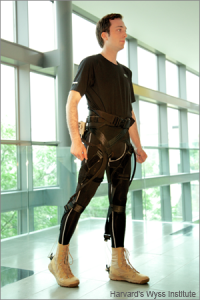Wearable robot will put a spring in soldiers' steps
The lightweight, flexible Soft Exosuit being developed at Harvard can cut down on fatigue and musculoskeletal injuries.

Soldiers are used to being weighed down by what they wear, especially when it can add up to 100 pounds or so. But researchers are working on wearable gear that could actually do the opposite, reducing fatigue and the risk of injury when carrying heavy loads.
The Defense Advanced Research Projects Agency just awarded a $2.9 million grant to Harvard University’s Wyss Institute for Biologically Inspired Engineering to continue its work on the Soft Exosuit, which is pretty much what it sounds like—an exoskeleton made of soft, comfortable fabric combined with some robotics that assists the leg muscles and joints when walking.
Exoskeletons are often thought of as heavily armored Iron Man-type suites that require a lot of power and restrict the wearer to rigid, Frankenstein-like movements. But DARPA, through its Warrior Web program, has been looking to lighter and more flexible, specifically to help soldiers carry their gear. Musculoskeletal injury is the most common reason for discharge from the military.
"While the idea of a wearable robot is not new, our design approach certainly is," said Conor Walsh, A Wyss core faculty member and leader of the research developing the suit. Designed for the lower half of the body, the suit is pulled on like a pair of pants and is worn under a soldier’s gear. It has a web of straps with a low-power microprocessor and strain sensors. Power comes from a pair of fanny pack-style batteries. The suit monitors such things as the suit tension and the wearer’s position, and provides subtle assistance to the legs in motion without restricting movement.
Wyss’ earlier work on the suit was also funded by DARPA, and the current award is the first part of a potentially two-phase contract. During the suit’s development, research has led to new kinds of textiles, flexible power systems and soft sensors, along with new methods of human-machine interaction, according to the lab. And the work could have an impact outside the military as well, such as with assisting people who have limited mobility or aiding first responders.
The Soft Exosuit is the lightest of the exoskeletons the military is working on. The Special Operations Command, for example, is funding development of the Tactical Assault Light Operator Suit, or TALOS, which is relatively lightweight but is loaded with sensors, armor and fire-resistance materials. NASA also is developing the 57-pouns X1 robotic exoskeleton for use both in space as well for rehabilitation of people with serious leg or spinal injuries.
NEXT STORY: Researchers 'grow' lasers in chip breakthrough



